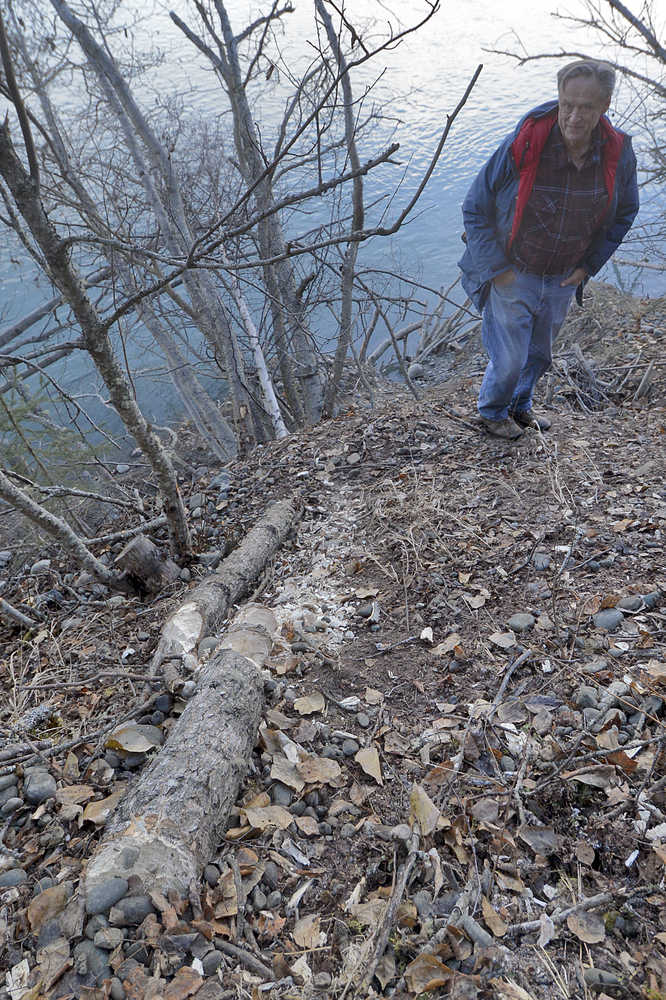This fall Soldotna mayor Nels Anderson realized he had a beaver problem.
The home he shares with his wife Carla Anderson is located on the top of a steep hill that overlooks, and leads straight down to, the Kenai River. Trees grow at a slant down to the banks of the massive waterway.
“I can tell you all I know is that my son went down and found that beavers were taking the trees off of our property,” Anderson said with a laugh. “They were using them to build their home in front of Kurt Olson’s house.”
At first Anderson thought he was about to lose all of his trees. When he called the Alaska Department of Fish and Game to remove the animals, he was told that according to Soldotna’s city code, they were unable to trap the beavers within city limits.
After a reinterpretation by City Manager Mark Dixson, the situation was sorted out.
Animal Control Officer Marianne Clark said beavers rarely try to make their homes inside city limits. The beavers roaming around on the Andersons’ property were the third case she has been made aware of in her 13 years working for the city.
Clark said Animal Control has no jurisdiction over wildlife that enters the city proper. The ordinance titled “Animal Cruelty or Injury to Animals,” outlines how to handle nuisance animals, she said.
Dixson determined that trapping within the city is legal as long as it is not a threat to any domestic animal and the Animal Control is able to monitor the situation, Anderson said.
Only Fish and Game has the authority to approve the removal of wild animals inside the city, Clark said. However, Fish and Game has to keep Animal Control in the loop. The city has to be made aware of what removal method Fish and Game has approved if it has the potential to harm domestic animals, she said.
If some one needs wildlife relocated however, how that will happen is between the Soldotna property owner or organization and Fish and Game, Clark said.
Department of Fish and Game wildlife technician Larry Lewis said his job is to make sure the removal happens in the most ethical and legal way possible.
He said in the case of the Andersons’ beavers, he was able to set the couple up with a local trapper, since trapping season will begin on November 10.
“Sometimes the removal can be mutually beneficial,” Lewis said. “There are plenty of local trappers looking for opportunities.”
Unfortunately at this time of year Lewis said, non-lethal removal is impossible. Because the beavers dam system contains their food cache, simply relocating them is basically a death sentence, he said.
In warmer weather relocating a beaver somewhere they will be able to rebuild and restock their food supply is a possiblity, Lewis said.
Under more innocuous circumstances, Fish and Game can issue special trapping permits outside of the legal trapping season, Lewis said. In the past he has coordinated the removal of a beaver colony in downtown Kenai.
The dam the animals were building began to threaten the integrity of a state road, Lewis said.
In that case the beavers were removed during the off-season because it was a safety issue, Lewis said. When the wildlife is a threat to humans or pets they will make exceptions, he said.
Besides lethal removal or live traps, there are other ways of handling pesky beavers, Lewis said.
Fish and Game encourages property owners to wrap the threatened trees in material such as a wire fence, he said.
Bears, moose and coyotes are other animals that wander into the city may cause problems for residents, Clark said. In most cases Fish and Game will be called in, but sometimes city officials will simply need to scare them out of a populated area.
“Sometimes we have bears or moose wander onto the Soldotna Airport runway,” Clark said. “We just have city personnel scare them off.”
Clark said she recalls one instance where beavers were creating flooding near a culvert in the city one year.
Eventually the Department of Transportation had to have them removed because they were causing erosion underneath that roadway, she said.
Beavers can be an annoyance for property owners, Lewis said. But that is just what beavers do.
If it is not life or death they have to be removed in an ethical, safe method, Lewis said.
Reach Kelly Sullivan at kelly.sullivan@peninsulaclarion.com

